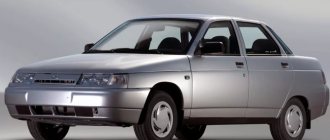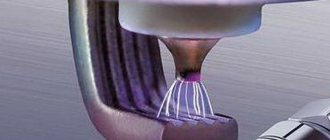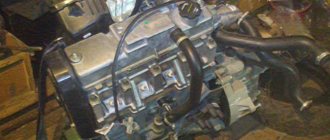Andersson received wide resonance in the automotive world. According to rumors, the reason for the resignation was the company manager’s love for foreign spare parts. Everything would be fine, but in the end the cost of the new product from the Volzhsky Automobile Plant turned out to be higher than expected.
In Russia, the attitude towards Bo Andersson's politics is ambiguous. Some car enthusiasts agree that finding high-quality domestic spare parts is almost impossible, while others are confident that the Russian auto industry needs to be developed. While supporters and opponents of the creator of the Lada Vesta were arguing, at one of the car repair shops they completely dismantled the car to see what it was made of.
For analysis, we took the Comfort package for 550 thousand rubles. If we analyze the configurations offered by the Togliatti Automobile Plant, it is Comfort that is the optimal combination of price and quality. A car with an automatic transmission has a not entirely successful robotic gearbox.
Engine
The engineers put a good engine under the hood: a 16-valve naturally aspirated 4-cylinder engine, which produces 106 horsepower at 5800 rpm and a torque of 148 Nm at 4200 rpm. According to experts, it is characterized by good responsiveness and elasticity, but produces noise at high speeds. If the owner is not embarrassed by this fact, he will like the car.
True, with the engine, not everything is as welcoming as we would like. The engine sits close to each other under the hood, so getting to it from any side for repairs will be quite difficult. The motor is literally shrouded in wires.
The electricians who took part in the disassembly of the Lada Vesta had to disconnect four dozen connectors, having difficulty removing the clamps. It’s hard to imagine how the car owner will do this (and there are many buyers of the Russian automobile industry who like to repair cars in their garage).
The disappointing discoveries don't end there. An oil filter made in Russia is installed end-to-end between the subframe and the exhaust manifold. Moreover, it is not protected from the latter by anything, which during operation can backfire on motorists. If you decide to change the oil filter, you are in for a delicate and meticulous job. It will be difficult to do this yourself in a garage without professional equipment.
The drive belt and tension roller barely fit under the hood. However, exactly the same as the timing mechanism. To change these spare parts, you will have to work hard, disassembling almost half of the car. So get ready if you like to repair cars yourself in your spare time.
Another surprise awaited us at the official service: the engine sump can only be removed together with the gearbox. This is caused by the peculiarities of the fastening, which is unlikely to please car enthusiasts.
Manual transmission
It's the turn of foreign components - a 5-speed manual transmission. There are also Russian “notes” in the box, because the transmission housing is cast in-house at AvtoVAZ. The complete assembly of the gearbox is also carried out at the plant in Togliatti, so it’s impossible to call the gearbox truly French.
AvtoVAZ engineers had to buy a gearbox from foreign suppliers, since they could not find a worthy analogue in Russia. In domestic transmissions, irritating noises are invincible, especially the hum of gears. It is clear that the French transmission cost the automaker more, which naturally affected the final cost of the vehicle.
Improved protection
The primer is applied using a galvanic method in a bath, where the body is completely placed in the soil and all cavities and hard-to-reach places are covered with a thin protective layer. This in turn allows you to get good quality Vesta bodywork.
These technologies used in production preparation and painting do not in any way affect the rigidity of the finished product. AvtoVAZ does not use galvanized sheets when manufacturing the car, but when asked what kind of body the Lada Vesta has, the dealer gives the answer: it is completely galvanized, which complies with the current standards at the plant.
Now the plant is working on the problem of creating hot-dip galvanizing technology, although this method is expensive, AvtoVAZ sets itself the goal of achieving the same quality of preparation and painting of bodies as that of the world leaders in the automotive industry. And then no one will have a question about what the body of the Lada Vesta is made of.
Automatic transmission
But on the basis of Russian technologies, a robotic automatic transmission was developed. The problem of noise is relevant for an automatic transmission, which is especially loud when shifting into second gear. There is no such complaint about the French components installed in the Comfort package.
Lada Vesta has Valeo radiators. The components are of excellent quality despite the fact that, according to unofficial information, they were assembled at a plant in Tolyatti. Ensure uninterrupted operation of systems without causing any problems.
When trying to find out more information about radiators at the Russian representative office of Valeo, it was not possible to obtain clear information. We were switched from one specialist to another, but we never found the person responsible for cooperation with AvtoVAZ.
Car device
To imagine the size of the car, you can look at the Volkswagen Polo. Vesta and its wheelbase are only a few centimeters longer. Its total length is 4.41 m with a width of 1.76 m and a height of 1.49 m. When fully equipped, the car will weigh from 1150 to 1200 kg. Exact weight may vary depending on version. The thickness of the Lada Vesta metal can vary from 0.6 mm to 0.8 mm, and in some places, possibly more. There is no reason to believe that the new model will differ in any way from the Lada Priora or Lada Granta. The car was developed on the basis of the V/C platform, which continued the previous C design. Unlike the Lada Silhouette, its successor received many updates: completely updated control with power steering, modernized electrical equipment, imported climate control and a modified rear suspension base.
Generator
The Lada Vesta has a Valeo generator, but it is no longer Russian, but Turkish. The appearance of the generator is somewhat surprising, because instead of the traditional bright varnish, its winding is covered with some other paint. But this nuance is unlikely to affect the operation of the generator itself. Among the conspicuous shortcomings, we note the crimped, but not soldered ends of the winding. A small thing, but unpleasant.
If a vehicle owner decides to repair or replace the generator, it will, frankly, not be easy to do. The fact is that it is tightly clamped on all sides by the air conditioning compressor and its pipes, by the wall of the engine compartment. So you will have to remove the compressor, which is difficult to do yourself in the garage.
It is not clear why AvtoVAZ engineers made repairs so difficult. I would like to hope that this is not so that the owners come in for service more often, and do not, as is tradition, repair their houses.
Under the hood you can still see a Polish starter, a release bearing and a Czech-made climate control unit of the same brand. It’s not surprising, since the French are the main supplier of spare parts for many automakers.
Lada Vesta components
Among the known features, Lada Vesta will be equipped with an automatic ERA-GLONASS transmitter. This system, in the event of an accident, will automatically send a signal with a request for help and GPS coordinates to the main rescue services. The government plans to pass a law according to which such transmitters will be required to be built into all cars on the Russian domestic market.
The mid-level “Comfort” package will contain the following set of functions: GPS, advanced climate control from Valeo , air conditioning, video recorder in the form of a rear view camera, two airbags, cruise control, electric windows on all doors from the Bavarian Brose , 16-inch alloy wheels “rollers”, light and rain sensors and a heated front window function. It is this type of configuration of the Lada Vesta that is planned to be produced from the very beginning.
Individual spare parts are the result of the work of many manufacturing companies. However, most of them have production in our country. Thus, the car will be supplied with Continental tires , a well-known German manufacturer. If the Continental Eco Contact model is installed, this is one of the company’s cheapest kits. The car radiator from Visteon Corporation , a leader in the world of spare parts, is made of very high quality. Ventilation and brakes will be from TRW , and the generator, windshield wiper and accelerator pedal will be from the world famous Bosch . In addition, the seats are from the Korean company Daewon , and the interior parts are from AE2 . The latter manufacturer is known for its developments for many cars, for example, for Nissan. The creators of the car surprised us even more by installing a high-quality electronics control unit from Lear . Its price on the market is above average.
As you can see, when developing the LadaVesta, they saved on some details, while others are quite consistent with the price category of the car. In other words, manufacturers from all over the world. However, this should not surprise us; VAZ, like others, follows the latest trends.
However, the company is not going to stop there. It is planned to release (possibly with all-wheel drive) the Lada Vesta Cross SUV. This will happen in the middle or second half of 2016.
As we have seen, the release of the new car can rightfully be called historic. How popular will it become? How will he be accepted among Russian motorists? Time will answer these questions.
VAZ VESTA surprises with its spare parts) I already wrote that Lada Vesta is a VAZ, but this applies only to its assembly. But you will be very surprised by what sticks it is assembled from.
I would also like to note that I already wrote an article about the fact that Lada Vesta is Renault Logan. There were a lot of fanatics who said that this was a new Lada B platform. Let's say they are right, I'm wrong, but in general the car was created in order to oust Logans from the market as the most popular taxi car.
If we take the new Logan and Lada Vesta, then most likely everything worked out here and Vesta really looks nicer in appearance and price. And you can even put up with her mistakes, since Logan has them too.
But Vesta failed to conquer the taxi fleet because the price is still higher and today Granta is taking the top places. Since its design resembles Vesta in some ways and at the same time costs an order of magnitude cheaper.
But let's talk about what kind of VESTA is made from?
Oddly enough, most of the spare parts are foreign. That is, you can even say that this is a foreign car. It still doesn’t reach the quality of foreign cars, because it’s a hodgepodge that was also assembled at AvtoVAZ, but the spare parts are really foreign.
I wouldn’t find fault with the quality so much; after all, Vesta is cheaper than any budget foreign car. As for spare parts, the model on the market is new and for this reason the prices for spare parts are on par with foreign cars.
The video was taken with special love from the channel Anatoly Evseev https://www.youtube.com/channel/UCVN65nwTWvNS2IG4p8_y8kg support Anatoly with your royal like and subscription!
Electronics
The Russian Lada Vesta received a fuse box exactly the same as on the Reno Logan. It’s too early to rejoice, since AvtoVAZ has already announced that the “native” manufacturer from the Samara region will soon become the supplier of fuses. So it is unclear what the quality of the new components will be and who will supply them to AvtoVAZ.
At first glance, we had no comments about the block itself, but upon closer inspection, we discovered two “extra” fuses. They ended up in the block, but I couldn’t find them in the instructions. Having analyzed the electrical circuit, I had to draw a disappointing conclusion - if a sudden voltage surge occurs, the fuses will blow and the battery will not charge.
By the way, it is not so difficult to provoke a sharp jump. It is enough to do a good deed and “light” the car with the engine running.
What’s sad is that the driver will not immediately find out why his favorite car won’t start. When discharging, it is stubbornly “silent”; no indicator lights are visible. We can only hope that with routine diagnostics of the system it will be possible to identify the cause of the car breakdown. In any case, the owner will have to take the vehicle to an official car repair shop for repairs.
The controls are foreign. The Lada Vesta has a steering rack from ZF from Germany, CV joints from GKN from Poland. During the inspection, no comments arose regarding them.
Why use a primer for galvanizing?
If everything is clear on the inside, there is no protective layer and primer is required - but why apply it to the outside, where there is galvanization?
If you remember, I wrote above that the larger the layer of this non-ferrous metal, the longer the body steel lasts. SO - the layer that is sprayed is not so large and it needs to be further strengthened.
According to materials science reference books, a ZINC layer 100 microns thick is enough for about 87 years. And the thickness of the “cold method” on the VESTA body is 10 microns
That is, ideally it should be enough for 8.7 years, that is, almost 9 years. However, AVTOVAZ does not provide a guarantee for such a period, due to several factors:
- Application is carried out by spraying, and there is no guarantee against defects (especially if painted by hand).
- As practice has shown, the layer is often about 8 microns
Thus, they extended a 6-year warranty on the body; by the way, when this model was launched, they wanted to give it 4–5 years. Now technology has improved a little.
Brakes
Almost half of the European countries had to work to stop Lada Vesta. While disassembling the brake system, we saw bearings from France pressed into the rear brake drums from Germany. The spare parts are not bad - European quality at a European price, which is reflected in the cost.
And immediately the bad news is that the vehicle owner will not be able to change just the bearing; he will have to change the entire assembly, which is expensive and offensive. We can only hope that the European components will not let you down and will work for more than one year. Buying a complete assembly instead of one part is an expensive proposition.
The cylinder and vacuum booster came from Poland, the calipers and pads came from the Czech Republic, and the hoses came from Turkey. At first glance, there were no comments about this European “hodgepodge”, but after taking a closer look, there were some. Part of the clamping area extends beyond the front pads. It is impossible to say unequivocally that this feature will affect the operation of the vehicle. During the test drive of the car, there were no complaints about braking.
Suspension
When repairing a suspension, the car owner will have to “sweat.” The ball comes complete with a lever. Its repair and replacement will require a lot of space, and according to employees of official car service centers, ball play and knocking of stabilizer struts are a common reason for calling for repairs. Car owners will have to either rack their brains to repair it themselves, or take the car to a service center and pay a lot of money.
But the shock absorbers are domestically produced. And despite the fact that they came off the assembly line in Ryazan, there are no complaints about them. In addition, experts say that the balance of characteristics of the suspension is considered one of the best in its class.
By the way, we still found the inscription “Made in China” on the car. It turned out, who would have thought, on the wiper drive motor.
Our “foreign car”
At Vesta, for the first time, external galvanization of the body was used with a guarantee against through corrosion for six years. The cars of the first production confirmed that metal with such a coating rusts reluctantly. If the damage does not reach the ground, then the scratches do not grow. An anti-gravel coating is applied to the sills and the bottom.
Inside, the car resembles a budget foreign car in a good way. The cult of straight lines from the past is no longer there: they have been replaced by smooth curves.
The most affordable configuration includes driver and front passenger airbags, a steering wheel adjustable in both directions, power windows on the front doors, electric drive and heated exterior mirrors with side turn indicators. In the “base”, the height of the seat belts can be changed, there is a cabin filter, and the key blade is foldable - it’s these little things that make the car easier to own.
The car is relatively quiet. The main noise from the road enters the cabin through the arches. Gluing them with a layer of sound insulation significantly improves acoustic comfort.
The trunk volume of the Vesta is the envy of the class above: 480 liters, which fit comfortably in the wide “jaw” behind the trunk lid. A station wagon with a folded sofa is ready to offer 825 liters for the most valuable.
Salon
We will not highlight any details, since they came to Tolyatti from all over the world. When designing a car, engineers decided to assemble their own small collection of foreign components.
Let's start with the air filter. He came to Tolyatti from Germany, the filter and housing are from Mann+Hummel, respected by many car enthusiasts. The electric fuel pump assembly is Russian, Arsan brand. The radiator tank hose came from Bulgaria, Teklas brand. The washer reservoir is from the French Renault, the pump came from Continental.
If you look at the plastic elements inside the car, everything is made in Russia. And, let's admit right away, there is nothing good in this discovery. Already at first glance it is clear that the salon is inferior in quality to foreign competitors.
The quality of the fastenings is frankly poor, since the parts give play and fall out at the slightest touch. This is a clear omission that leaves an unpleasant aftertaste. Of course, the Lada Vesta does not belong to the premium segment, but buyers expect to see a not luxurious, but still neat interior for their money.
Another unpleasant discovery - the plastic frame of the manual transmission lever clearly did not fit into its place. It was sharpened from the inside and it seemed that it was sharpened by hand with an ordinary file. This approach to the mass production of expensive cars is, to say the least, puzzling.
Among the shortcomings in the cabin, we can note the presence of gaps and an abundance of some kind of uncovered screws. The Lada Vesta is put together much better than the Zhiguli, but when you get into the cabin you can’t shake the feeling that something is about to go wrong. But I really wanted the Russian auto industry to be as good as the foreign one.
Not long ago, a complete list of component suppliers for AvtoVAZ was published by the Avtostat agency. Interestingly, the stated data did not always coincide with reality. For example, the car has Pirelli tires, and not, as stated, Continental.
When did production begin, its features
In September 2015, the manufacturing process of the Lada Vesta car began. Two months later, the product is released for sale. At first, the model was seen as another failure, but today Lada Vesta is being sold in fairly large quantities, along with some foreign cars. The advantages of the car include:
- Affordable and reasonable price.
- Comfortable living conditions inside.
- Attractive appearance and sufficient capacity.
- The standard assembly now includes ESP and ABS.
- The presence of two airbags.
The new Lada Vesta sedan is assembled and produced in Izhevsk, where the Lada Granta liftback is produced. Renault engineers helped develop the body, which was designed using the latest software. The car frame is not inferior in strength to the Ford Focus. This was proven already in the first crash tests.
Body
From the outside, the Lada Vesta looks quite nice, you can’t argue with that. After a thorough analysis of the body, we can say that it is really well assembled. The gaps are no more than 2-3 mm, as expected. The doors close softly and quietly, which is worthy of applause for the Russian automobile industry.
Our analysis would have ended there if we had not looked down. A number of unpleasant surprises awaited us here. The sloppy anti-corrosion treatment is striking. Employees of the car plant in Tolyatti probably considered high-quality body treatment unnecessary. Some areas were treated directly on top of the film, which was then not very carefully torn off. I would like to believe that such negligence only happened on the car that fell into our hands.
Here another incident emerged - there’s no other way to describe it. A piece of paper was glued to one of the parts with the name of the color in which it needed to be painted. It's funny that the employees painted the part, but didn't bother to remove the inscription before painting. Someone else had already partially torn it off, leaving an unpainted strip in place of the sticker.
The accuracy of internal bends and connections of individual body parts is questionable. If you look closely, you can see technological holes where dirt, salt and chemicals will get in during the operation of the vehicle. If we take into account poor anti-corrosion treatment, there is reason to believe that these places will become hotbeds of corrosion. There is no hope that the car will serve for many years.
In order not to be verbose, we lifted up a direct competitor of the domestic auto industry - the Skoda Rapid liftback in the basic configuration. At the bottom there is an armor-piercing shield, which is securely packaged in perfect protection and two plastic sheets on top.
Four types of technologies
A little about why zinc (Zn) protects steel - it is a non-ferrous metal, has a more negative potential and corrodes first (that is, when it collapses, it protects the coating underneath), and the protection works even when it is damaged or partially destroyed.
It becomes clear that the larger and thicker the zinc layer, the longer the car body is preserved and no corrosion occurs.
To apply particles of protective metal to the body, there are only four main technologies, I will list them from best to worst.
- Hot method. When the fully assembled body is dipped into a bath filled with zinc. Moreover, the temperature stays around 460 – 500 degrees Celsius. The method is very expensive and costly. Used by expensive brands on luxury cars - PORSHE, VOLVO, now on some premium HYUNDAI, etc.
- Galvanic method. The method consists in the process of deposition on the cathode (in our case, part of the body), positively charged particles (ions) of zinc from aqueous solutions (electrolytes). This technology works by passing a direct electric current through it. This is a less expensive and simpler technology, used by Mercedes, BMW, TOYOTA, Honda, Mitsubishi, KIA, etc.
- Zinc metal. It is used mainly by KIA, on cars from the “C” class. This is a kind of plastic coating that consists of two layers.
- Cold method. In essence, this is a kind of painting. A powder is applied to the body parts, which contains small particles of zinc powder. Used by many brands (Chevrolet, KIA, HYUNDAI, TOYOTA) including AVTOVAZ.
As you understand, VESTA is processed using the third technology; you choose where and in what volume to apply this layer.
This is where the disadvantages appear, namely the uniformity and thickness of the coating. It is also worth remembering that this layer is not 100% corrosion protection; it needs to be further strengthened.
Bottom line
The result is ambiguous. If we compare the entire domestic auto industry, the Lada Vesta is strikingly different in the quality of components and assembly. But there are still some shortcomings, they are annoying and not too minor. Domestic cars are practically no different in price from foreign competitors in their segment, while the quality of the latter is much higher. It is clear that in this case buyers will most likely buy a foreigner.
You can, of course, talk about patriotism and support for the domestic automobile industry, but you cannot call Lada Vesta Russian. The car consists of a huge number of foreign components. And even if some of them are made in Russia, they are made from foreign raw materials and based on technologies brought from abroad.
About myths
Almost everything has been clarified, but again, many skeptics who are accustomed to saying that there is nothing good at AVTOVAZ can put forward some theses:
- Foreign cars are made from fully galvanized sheets . Perhaps someone does this (in their barn in particular), but in most industries around the world such sheets are not used. They are soft (do not have the required strength), do not weld well (easily burn through), the cost of the body will go through the roof
- The cold method is used only at AVTOVAZ . This is also not true, for example Chevrolet, KIA, HYUNDAI, TOYOTA, MITSUBISHI use it on many of their cars (even if they are of a budget class, but still). For example, CRUZE is covered worse than VESTA, it does not have sill treatment and some front power struts
- The layer is so thick that it falls off . I really don’t understand who comes up with this idea. If you check with a micrometer, it turns out: the roof is about 105-125 microns, the doors are about 145 microns, the wings are 140 microns, the hood is 110 microns, the trunk lid is 120 microns. This is a complete “pie” that is applied to the steel. It is approximately the same as on many foreign cars of this class and nothing falls off on anyone.
- Only VESTA is processed; other VAZs are not treated ! This is again a myth. Galvanization is applied to the following models: GRANTA (LIFTBACK) - fifth door, fenders (here is the bare minimum of galvanizing), KALINA2 - all external surfaces, except the hood, roof, front and rear side members (fender liners are needed here), PRIORA (since 2009) - everything except the roof, hood. X-RAY - everything outside, except the roof, VESTA - the entire external surface, with the bottom, sills and arches additionally treated with anti-gravel.
As you can see, a lot of things are far-fetched, now I’m providing you with a video version, let’s take a look.
I’ll end with this, I think it was useful, read our AUTOBLOG, subscribe to the channel.
( 13 votes, average: 4.00 out of 5)
The service life of metal products depends on how well the galvanizing is done. When buying a car, the buyer is interested in whether the body of the Lada Vesta is galvanized or not. AvtoVAZ uses innovative technologies when painting.
All the world's major auto giants are trying to produce high-quality cars that meet the latest standards. Particular attention is paid to the appearance, or rather the paintwork.
The use of the latest technology for preparing and painting the body allows you to extend the safety and integrity of the car body. First of all, auto giants coat metal with zinc.
Buy?
If you are planning to buy a Lada Vesta to save on service, we will upset you. You definitely won’t be able to repair a car in a garage yourself. Engineers assembled the vehicle in such a way that half of the car would have to be disassembled to replace parts. Please note that the parts are supplied from abroad, so they will cost a lot.
The final decision will have to be made by the buyer, based on the budget and willingness to accept the shortcomings of the Russian automobile industry.
Sitemap / News / Review / DIY / Tips / Auto stories
Coating technology at AvtoVAZ
The car body of a modern car is a high-tech product; remember how it rusts in old Lada models. “So what kind of body does the Lada Vesta have?” – car buyers ask. We will try to answer the question, galvanized or not. AvtoVAZ uses the cheapest method in its technology: galvanizing is done using a spray gun and applying a special composition.
The entire body of the car is processed. The plant does not receive ready-made galvanized metal, so the body of the Lada Vesta is made of black, and subsequently it will be galvanized. Further processing and painting of the car depends on how high-quality the primary coating is.











